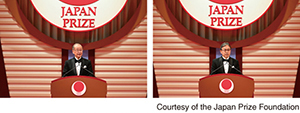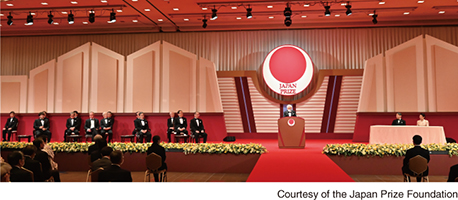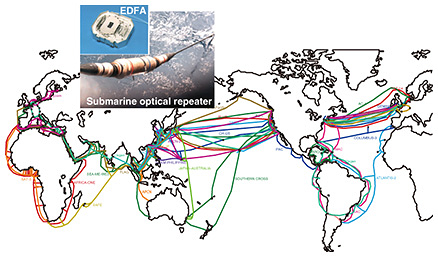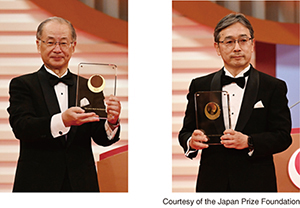 |
|||||
|
|
|||||
|
Special Report: Commemoration of the Japan Prize Vol. 21, No. 7, pp. 18–27, July 2023. https://doi.org/10.53829/ntr202307sc1 Keeping in Mind the Spirit Acquired at NTT Laboratories, We Will Continue to Challenge Ourselves to Contribute to the Development of HumankindAbstractMasataka Nakazawa, special honorary professor at Tohoku University, and Kazuo Hagimoto, principal researcher at National Institute of Information and Communications Technology, who both researched at NTT, have been awarded the 2023 Japan Prize. This award recognized the development and practical application of a compact optical amplifier that amplifies optical signals without having to convert them into electrical signals and its contribution to high-capacity optical communication systems that use such amplifiers. Prof. Nakazawa and Mr. Hagimoto paved the way for long-haul, high-capacity optical data communications, which is the key technology supporting the current global Internet society, and handed down important achievements that are incorporated in the concept of IOWN (Innovative Optical and Wireless Network) being advocated by NTT. To commemorate winning this award, we interviewed Prof. Nakazawa and Mr. Hagimoto. Keywords: Japan Prize, EDFA, optical repeater
Japanese researchers receive the Japan Prize for the first time in nine years in the field of electronics, information, and communications—Congratulations on winning the Japan Prize. We heard that you were both very surprised when you learned that you’d won the award. Prof. Nakazawa: I am very pleased to have received the award. I could hardly believe that I had won it. Because I have served as a member of the selection committee for various prizes, when I received a call from the Japan Prize secretariat in the late autumn or early winter of 2022, I thought they were asking me to be a member of the selection committee. However, some time later, the president of the Japan Prize Foundation contacted me and said, “Prof. Nakazawa, you have won the award. Would you accept it?” I was really surprised. I couldn’t believe that I had received the award, so I first answered, “Is it true? It is! Well then, I’m very honored.” I think Mr. Hagimoto felt the same way. Mr. Hagimoto: Yes, I was very surprised. The Japan Prize has been awarded to prominent researchers. I was more than surprised than delighted to learn that I could join them. I think it was sometime in November when I was contacted. To tell the truth, I also had some misunderstandings, which took me some time to settle until I could experience the joy of receiving the award. The Japan Prize secretariat contacted the National Institute of Information and Communications Technology (NICT), where I’m the principal researcher of the Beyond 5G R&D Promotion Project. However, since I was working from home, I didn’t understand the message clearly, and I was wary that the call might be suspicious, so it took me some time to realize that it was about the Japan Prize. I was told that Hiroshi Komiyama, the president of the Japan Prize Foundation, former president of the University of Tokyo, would call me, and like Prof. Nakazawa, I thought he would be talking about being the selection-committee member. However, for a moment, I thought, “The president has taken the trouble to contact me maybe because I am receiving the award...” But I thought, “That’s impossible.” Prof. Nakazawa: Receiving the Japan Prize is such an incredible honor. The Fields Selection Committee determines two fields in which the Japan Prize will be awarded two years later and announce those fields in November every year. Then, more than 15,000 nominators from around the world nominate the candidates, which are subjected to a rigorous selection process that takes into account excellence in science and technology, degree of contribution to society, and other factors. I heard that I had been nominated several times in the past, but we’re not pursuing research to win prizes, so I forgot that I was previously nominated. Even so, I’m more than happy to be recognized for having changed the shape of information and communications on a global scale.
—What is the relationship between the two of you? And how did you come to work in the same field of research? Prof. Nakazawa: We both joined NTT (then Nippon Telegraph and Telephone Public Corporation) the same year (1980), myself as a Ph.D. in engineering, and Mr. Hagimoto as a master of engineering. Mr. Hagimoto: When I met Prof. Nakazawa for the first time at a job interview, I discovered that we actually went to the same university (Tokyo Institute of Technology). Although we were in different years and had never met face to face, we have been close ever since. Prof. Nakazawa: After receiving training as a new employee, I was assigned to the former Ibaraki Electrical Communication Laboratory, where I was engaged in research on technology for identifying broken optical fibers in optical communications, and Mr. Hagimoto was engaged in research on transmission systems using optical fibers at the former Yokosuka Electrical Communication Laboratory. Mr. Hagimoto: Symbolic of our joint research is our paper on the erbium-doped fiber amplifier (EDFA), which led to the Japan Prize, presented at the Optical Fiber Communication Conference (OFC) in 1989 (Fig. 1). Hearing from Prof. Nakazawa’s colleagues specializing in optical fibers that gain could be obtained with a semiconductor-laser-pumped erbium-doped fiber (EDF), I began preparing for experiments on optical amplification using EDF from the end of 1988 to the beginning of the next year. It was a fairly rushed project. With only about two weeks were left before the OFC deadline, we conducted the world’s first transmission experiment using an optical fiber amplifier.
Distinguished contributions to global long-distance, high-capacity optical fiber networks through the development of semiconductor-laser-pumped optical amplifier—Now let me ask you about your achievements recognized by receiving the Japan Prize. The citation for the award was given as follows: “Through their development and practical application of semiconductor laser pumped optical amplifier, Professor Masataka Nakazawa and Mr. Kazuo Hagimoto have made major contributions to wavelength division multiplexing (WDM), quadrature amplitude modulation (QAM), digital coherent transmission technologies, and other elements necessary to achieving long-distance, high-capacity optical fiber communication networks. They helped carve out a path for the basic long-distance, high-capacity optical data communication technologies needed to support intercontinental communications through submarine optical fibers, and to handle the immense annual increase in data volume our global internet society deals with today.” Can you give us some background information concerning these achievements? Prof. Nakazawa: In the 1980s, optical communications using single-mode fibers were put to practical use; however, for long-distance communications, it was necessary to install repeaters every several dozen kilometers to electrically restore the signal weakened due to attenuation as light propagates through an optical fiber and retransmit it. In other words, the optical repeaters used electrical amplifiers with which optical signals are converted into electrical signals and increased (amplified) the signal strength, and the amplified electrical signals are then converted back into optical signals and transmitted. However, the bandwidth of signals that can be handled by electrical amplifiers was narrow, signals were sometimes distorted, and equipment including photodetectors were large and consumed much power; therefore, there was demand for optical amplifiers that amplify optical signals without having to convert them into electrical signals, which would make it possible to amplify optical signals within the wide bandwidth using compact amplifiers. In response to this demand, Mr. Hagimoto and I have developed a compact, highly efficient, broadband optical amplifier, EDFA, which had been said to be difficult to put into practice. This EDFA had excellent features, namely, high speed, high capacity, low noise, low latency, compactness, and high reliability. I proposed the world’s first method of using a 1.48-μm InGaAsP (indium gallium arsenide phosphide) semiconductor laser diode as a light source for exciting EDFs. In the 1.5-µm band, which is the minimum loss wavelength band with attenuation due to scattering and absorption of 0.2 dB/km, an amplifier using this method achieved a gain of 12.5 dB over a wide wavelength range of more than 50 nm. This method made it possible to develop a compact, battery-powered broadband optical amplifier with size of only about 10-cm square—significantly smaller than conventional amplifiers, which required an extremely large excitation light sources of about 1.5-m square. I received positive evaluations stating that the developed laser has opened up prospects for building a practical optical communication system. Mr. Hagimoto: On the basis of Prof. Nakazawa’s proposal, I increased the output power of his optical amplifier and successfully conducted a long-distance transmission of 212 km using a 1.8-Gbit/s intensity-modulated direct-detection (IMDD) system, demonstrating its practicality of optical amplifiers for the first time in the world. Our achievement has been recognized as a major breakthrough in the practical application of optical communication systems; namely, our EDFA was widely adopted as an optical repeater in long-distance transmission networks such as the trans-Pacific and trans-Atlantic optical submarine cables for connecting the world in about five years after the development of the EDFA (Fig. 2).
EDFAs can amplify multiple optical signals at different wavelengths simultaneously; therefore, combined with the development of high-capacity technology such as WDM, the use of optical communications has grown rapidly since the mid-1990s. I was also recognized for leading the international standardization of this technology. Although other methods of optical amplification have been developed, using EDFAs remains the world’s dominant method. Our achievements have been recognized for enabling the diversification and increased capacity of information resources used on the Internet around the world as well as for enabling the provision of high-speed, large-capacity optical communication systems at low cost, which supported the explosive growth of the Internet. —The citation for the award also states that your work “has made possible the dramatic expansion of the social networks, cloud services, and other elements of the information infrastructure we use in our daily lives.” Your hard work paid off, and you played a part in building a modern information society. Prof. Nakazawa: Our work is like an unsung hero; that is to say, it is generally taken for granted that communications are always connected, but being connected is actually an amazing thing. Winning the award reminded me of the days when I was wrestling with the problems of extending the transmission distance of optical signals and identifying the location of breaks in fibers. Mr. Hagimoto: Yes, that’s right. I remember that at that time, my colleague and I were conducting experiments by installing a repeater in a maintenance hole. We had to go down the maintenance hole in which the repeater was installed for transmission experiments. Maintenance holes are dangerous places because of the thin air and accumulated rainwater, so I thought that if we could operate such a repeater in the future for long-distance transmission, we would be able to reduce the number of repeaters, thereby reduce such dangerous underground work. —It seems you’ve been through a lot of dramas, but could you tell us a little about the stories behind the development of the EDFA? Prof. Nakazawa: In a system for detecting break points in optical fibers, since the level of Rayleigh scattering in optical fibers is extremely low, it is necessary to input strong optical pulses into the fiber under inspection; however, in 1980, high-power semiconductor lasers that could achieve strong optical pulses were not available. Therefore, in collaboration with a group from NEC Corporation, we developed a YAG laser*1 operating at a wavelength of 1.32 μm and summarized the technical details of an optical time-domain reflectometer using such a laser in a document after subjecting it to an on-site test by evaluating Fresnel reflection loss. It was probably the first time that a solid-state laser was put to practical use for a communication-measurement device. Since the distance between repeaters of the single-mode optical fiber transmission system was about 80 km, we only needed to measure 40 km of fiber from one repeater; however, we needed a wide dynamic range, so we started looking for an even better light source. Optical pulses can travel through optical fibers the furthest at the wavelength band of 1.55 μm (the minimum loss wavelength); thus, a high-power light source operating at a wavelength of 1.55 μm can achieve the longest distance for detecting faulty points. Therefore, we looked at the oscillation wavelengths of various solid-state lasers and came up with erbium, which has a transition line at a wavelength of 1.55 μm between the ground state*2 (4I15/2) and excited state (4I13/2). It was the spring of 1982, two years after I joined the company. I immediately asked my supervisor for permission for creating an erbium laser, and he said, “Let’s give it a try.” However, at that time, I heard that a researcher had researched an erbium solid-state laser in the US, and no one was paying attention to it, and neither information nor technical papers were available. Therefore, we decided to fabricate our own laser rods from scratch and asked Hoya Corporation, which had been manufacturing neodymium (Nd)-phosphate laser rods, if they would be interested in fabricating erbium laser rods with us. The division manager of Hoya readily agreed, saying, “We’ve never done that before, but let’s give it a try.” If they had declined our request at that time, the EDFA might not have been developed. Two findings struck me as strange during the development of the EDFA. One is that erbium ions are optically active in silica glass. Normally, rare earths radiate light well in materials with small, non-radiative (phonon relaxation) transitions, such as phosphate glass and fluoride glass, but erbium is an exception. For the other finding, the excitation wavelength of Raman amplification for the 1.55-μm optical signal in silica fiber is 1.48 μm, which is the same as the quasi-two-level excitation wavelength of erbium. Who knows, if those excitation wavelengths of the two amplification methods were different, the EDFA might have taken longer to develop or it might not have been developed at all. It was thus fortunate that my group—as the only group in the world—was working on Raman amplification and erbium amplification simultaneously in one laboratory. Mr. Hagimoto: Although Prof. Nakazawa and I kept in touch, our research activities were split between Ibaraki and Yokosuka; however, Dr. Sadakuni Shimada, who was overseeing both of us at the time, encouraged us to cooperate closely in conducting experiments of a transmission system, and in 1989, we worked on the first transmission experiment using an optical fiber amplifier. The output power of the excitation laser at that time was not sufficient, and while devising ways to increase stability, we selected one EDF that satisfied the conditions. We then thought of using this fiber by dividing it in two according to the golden ratio (instead of simply dividing it into two) and rewind it. It subsequently became clear that the longer fiber was suitable for power amplifiers, and the shorter fiber was suitable for preamplifiers. It felt like magic that a wire that looked like just a fiber could provide enough amplification power to make up for the loss in an 80-km stretch of optical fiber. At that time, IMDD systems reached a dead end in terms of improving performance, and optical amplification was thought to be the final method to challenge coherent optical transmission systems. I still vividly remember our successful optical amplification transmission experiment in 1989, and the more experiments we conducted, the more impressed I was with the performance of the EDFA. Optical amplifiers can amplify multiple optical signals at different wavelengths simultaneously without distortion, and bandwidth can be secured even when 300 amplifiers are connected. In the blink of an eye, several projects began for relaying signals across the Pacific Ocean by using optical amplifiers only. I was surprised that KDD (currently, KDDI) and AT&T decided to apply optical amplifiers to their submarine systems, which emphasized reliability, at about the same time as it was adopted by NTT’s terrestrial system. I have wanted to conduct research that would impress people, but I was impressed by their quick decision.
Even if we take twists and turns, we are getting ever closer to our goal—The birth of the EDFA is an achievement that paved the way for long-distance, large-capacity optical data communications, which is the core technology that supports today’s global Internet society and led to IOWN. How did you successfully pursue research that leaves behind such outstanding achievements? Prof. Nakazawa: Impactful research achievements like the EDFA are rare, and research never ends once one mountain is climbed. Our achievements are based on our good fortune in encountering erbium and the tireless investigation of this material by various researchers in this field. If you know from the beginning that you should do something, everyone will take up the same challenge. Since that is not known, researchers not only increase knowledge but also expand connections with other researchers and combine materials, individual results, and knowledge, etc. to produce great results. Mr. Hagimoto: Dr. Shimada was very pleased with the results of our 1989 transmission experiment, but when I was preparing for my presentation of those results at OFC, he told me to get someone else to do the presentation. When I asked why, he said, “Because you will be much busier with a press release and subsequent correspondence.” So I had to ask a colleague to present the results that I had produced. In retrospect, he may have been worried that I was at the limit of my physical strength. I have fond memories of the fact that Dr. Shimada submitted the results to the Kenjiro Sakurai Memorial Prize of the Optoelectronics Industry and Technology Development Association that year (1989), and together with Prof. Nakazawa, we were awarded the prize. After that, although I stumbled in various ways from research to implementation, I managed to fulfill my objectives thanks to the support of my seniors and the research community, leading to receiving the Japan Prize. From an engineering perspective, standardization and collaboration are important to ensure that we deliver our achievements to the world, so sometimes it is necessary to let go of one’s attachment to own achievements. We are also grateful for the support of the government, which enabled us to form a dream team to assemble the intellectual property held by each organization and company, contributing to the success of our research. Cross-organizational cooperation can be difficult. However, I believe that Japanese researchers will be able to compete on the global stage and achieve outstanding results if we work together for the purpose of not only increasing Japan’s competitiveness but also contributing to society as a whole and the development of humankind. Prof. Nakazawa: Speaking of collaboration, Mr. Hagimoto was quick to recognize the importance of transmission equipment and optical amplifiers, so he worked with other companies to introduce them into an optical communication system. He also demonstrated his ability to connect people by taking the lead in international standardization. That is easy to put into words, but it is no mean feat. —Needless to say, researchers contribute greatly to the development of society and humankind. What qualities are required of researchers? Prof. Nakazawa: I believe that, by nature, people live their lives with the intention of improving their daily lives, and researchers are the ones who make that intention their profession, take pride in it, and feel a sense of mission. Having curiosity, passion, and a strong will is essential qualities for researchers. Even if no one expects you to do anything, it is important that you carve out a path for yourself and that you do your best. You have to be willing to enjoy your research even when you are having trouble. That is because even if you pursue research without making a detour, it does not necessarily mean that your research will bear fruit. I also think it’s important to study the things that you can only study when you’re young, because you can study the things that you can study through books when you’re older. I grew up in the countryside and lived in a world far removed from the research world, catching fish and picking the fruit of akebi (chocolate vine). When I was in junior high school, I liked making plastic models and vacuum-tube radios. I think that such experiences help deepen and improve the capability of a researcher. Mr. Hagimoto: Prof. Nakazawa’s pursuit of lasers for optical fibers and his contributions to the development of the technology have earned him extraordinary respect. When I visited him in his laboratory at Tohoku University, he was conducting experiments, as he did back then, and his enthusiasm was truly unwavering. He is now 70, but he seems the same as when he was in his 20s and 30s. That is extraordinary. There is no limit on his inquisitive mind. I’d like to emulate his level, but I cannot. I think that researchers have aspirations and dreams as well as the capability to approach things with curiosity while thinking, “I wish it could be better…” It is important to have the kind of curiosity that makes you want to climb a mountain that no one has climbed before. Researchers are the people who can sustain that feeling even when they face twists and turns. Looking back on my own path, I believe that if we do not forget our initial feelings, we will gradually get closer to where we want to go, even if there are twists and turns, and, at least, we will not go in the opposite direction. Doing something that you’ve never done before is the first step toward success—Could you tell us about the principal spirit you cultivated at NTT’s research laboratories? Prof. Nakazawa: When we joined NTT, it was still the Nippon Telegraph and Telephone Public Corporation. I think the research laboratories were, in a sense, a sanctuary, where excellent researchers from various universities gathered to conduct research and development in diverse fields. In this environment, we always conducted our research with an eye to how we could compete with the best laboratories in the world such as Bell Labs in the US. My supervisor was very open-minded and supportive. EDFAs were not my specialty at the time; even so, when I offered to do research on EDFAs, he said, “Sounds interesting. Why don’t you give it a try?” And he supported me by accompanying me to Hoya Corporation and securing the budget for the research. The spirit of supporting younger researchers with an open-minded and supportive attitude lives on in me, and I’m still competing with international researchers. Mr. Hagimoto: I cherish the words of Goro Yoshida, the first director of NTT laboratories, “Do research by drawing from the fountain of knowledge and provide specific benefits to society through its practical use.” NTT has been conducting a wide range of research from basic research to applied research in a wide array of fields, which is very rare in the world, and has contributed to society by collaborating with other companies for practical applications. According to Dr. Masao Kawachi (former director of NTT Science and Core Technology Laboratory Group), a center of excellence (CoE) is defined as “an organization in which second-rate researchers can produce first-rate results.” The fact that NTT has established its base technologies that can be reusable is an important asset and a foundation that enables the inheritance and development of value. In that sense, the ability to transform advanced technologies into devices, measuring instruments, equipment, subsystems, and other means of implementation is an important step toward the next generation. Cumulative progress, in which past technologies are accumulated and the next person climbs the stairs based on them, is the proof that “phase matching” is achieved in the organization. I can sometimes achieve results outside my field of expertise by superimposing new ideas on top of first-rate research results. I approach my research activities with this mindset, and I hope that the CoE will be passed on to subsequent researchers in the field of optical fiber communications as well. —Finally, could you give a few words to future generations of researchers? Mr. Hagimoto: To all future generations of researchers, keep your curiosity in mind and take a long-term view in your own research. I also encourage you to attend academic conferences because it is very important to have peers beyond the organization in your research activities. I expect your research activities will have an impact on society. Prof. Nakazawa: What I want to say to younger researchers who are conducting basic research is “don’t follow the lead.” I hope that you will have a frontier spirit and pursue new research with a dream. I know you have research that you are assigned to do, but I think you should have one research project that you’d like to pursue in addition to the ones you have been assigned. Therefore, you will broaden the scope of your research, and doing something you have never done before is the first step toward success. ■Interviewees’ profiles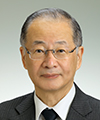 Masataka Nakazawa joined Nippon Telegraph and Telephone Public Corporation in 1980 and researched at the Electrical Communication Laboratory. He was a visiting scientist at Massachusetts Institute of Technology in 1984. He became an NTT R&D Fellow in 1999. He became a professor at the Research Institute of Electrical Communication (RIEC), Tohoku University in 2001, where he became a distinguished professor in 2008 then the director of RIEC in 2010. He also became the director of the International Advanced Research and Education Organization, Tohoku University and director of the Advanced Interdisciplinary Synergy Research Institute, Tohoku University in 2010. He became the director of Japan Council for Research Institutes and Centers of National Universities and the director of the Research Organization of Electrical Communication (ROEC), Tohoku University in 2011. He became a specially appointed professor of ROEC in 2018, when he also became the director (part-time) of Kanazawa University (to the present). In 2022, he became a specially appointed professor of the International Research Institute of Disaster Science, Tohoku University. He was granted the title of special honorary professor at Tohoku University in 2023 (to the present).  Kazuo Hagimoto joined Nippon Telegraph and Telephone Public Corporation in 1980 and researched at Yokosuka Electrical Communication Laboratory. He became a group leader at NTT Transmission Systems Laboratories in 1994, a senior manager of the long-distance network business unit at NTT Communications in 1999, an executive manager at NTT Network Innovation Laboratories in 2000, and the director of NTT Network Innovation Laboratories in 2005. He then became head of NTT Science and Core Technology Laboratory Group in 2009, president and chief executive officer of NTT Electronics Corporation in 2013, a fellow of NTT Electronics Corporation in 2019 (to the present), and principal researcher at National Institute of Information and Communications Technology in 2021 (to the present). |
|||||









